|
|
Post by Revolver Ocelot on Feb 29, 2008 8:43:25 GMT -5
I was really meh about Scrapped Princess primarily because I kept getting Xenogears vibes from watching the show right after the end of episode 3 (I THINK it was episode 3). Also, second opinon that's a little bit more toward my take on it. I'd like to say more about this series, but I haven't seen it for at least 5 years already. It is a good alternative to playing Xenogears though if you don't have 60+hours to spare. ... what? Okay, seriously, this is why dropping LSD before watching an anime is never a good idea. Or maybe it is. I dunno. |
|
|
|
Post by Revolver Ocelot on Feb 29, 2008 10:22:43 GMT -5
Megazone 23 Part III

Studio: AIC
Director: Kenichi Yatagai (first episode) & Shinji Aramaki (second episode)
Writer: Hiroyuki Hoshiyama
Producer: Toru Miura
Composer: Keishi Urata & Shiro Sagisu
Designer: Yasuomi Umetsu (characters) & Ichiro Itano (mecha)
Released: September 28th, 1989
Genre: Action, Cyberpunk, Sci-Fi, Thriller
Format: OVA series
Runtime: 2 episodes, 50 minutes each (100 minutes)
US License: ADV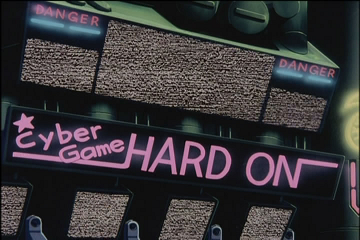 Megazone 23 Megazone 23[/i] was a sleeper hit and opened the eyes of many an anime fan to the world of the OVA. It had a thrilling cyber-punk plot and featured adult themes that were not normally seen on television back in the day. However, the OVA ended on a cliffhanger that would not have any follow up for well over a year. In 1986, Megazone 23 Part II[/i] was released, and while much had changed, it provided a decent conclusion to the story. So, when AIC released Megazone 23 Part III[/i] in 1989, people were wondering where else this story could go. 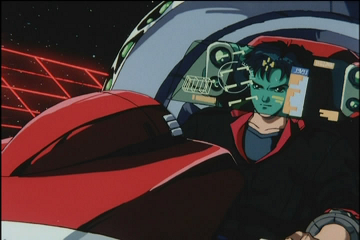 Megazone 23 Part III Megazone 23 Part III[/i] takes place some unspecified number of centuries after the apocalyptic ending of Megazone 23 Part II[/i]. People now live in a highly advanced city called Eden, where an organization called EX controls every aspect of the city and strongly polices the activity in the network which serves as Eden’s nervous system. Overseeing EX is a mysterious figure called Reverend Wong Dai, who has to deal with hackers constantly try to invade the system and uncover the secrets he is trying to keep from the citizens of Eden. This prompts EX to seek out talented young programmers to combat the hackers in a digital duel. The spotlight shines on Eiji Takanaka, a young gamer/software programmer/geek who lives for the arcades, playing the intense, virtual reality shoot’em up called “Hard On” (I shit you not!). 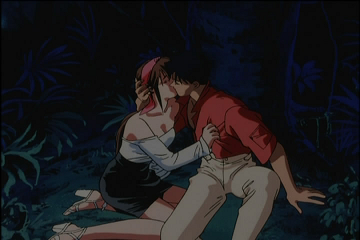 The OVA is split into two 50-minute episodes; The Awakening of Eve and The Day of Liberation. The Awakening of Eve introduces us to Eiji, who has just been recruited by EX. At the same time, a group of hackers called Orange is also trying to recruit Eiji, and they are not using the nicest means to procure him. While being caught in this tug of war, Eiji is also trying to romance Ryo, a girl he happens to be pretty sweet on. But Ryo is not the only girl that is giving him trouble. Like Shogo Yahagi before him, Eiji is destined to be the new operator of 7G, and is thusly haunted by the memory of EVE. 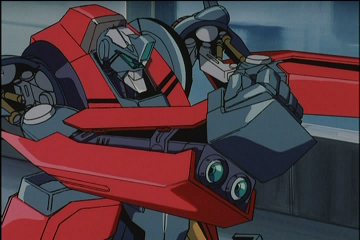 The Day of Liberation The Day of Liberation picks up after Eiji meets EVE. EVE wants to find out why Shogo Yahagi never awakened her all those hundreds of years ago, thus Eiji takes EVE to the ruins of Bahamut, the central computer that ran the Megazone system in the first two OVAs. There, EVE learns that Shogo Yahagi disappeared, but that his life data was somehow transferred to Eiji. Meanwhile, the final showdown between EX’s chief Jacov and Orange’s Shion begins to stir, and Eiji gets caught up in it. 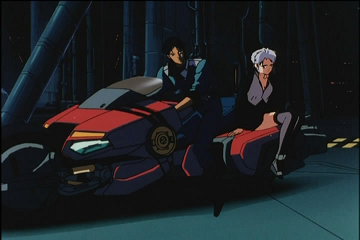 Just by reading the synopsis, you can certainly tell that Megazone 23 Part III[/i] is pretty convoluted. The problem here is that things are way too condensed. This OVA does not build on the story of the first two OVAs, therefore it has to re-explain everything and introduce a slew of completely new characters. While by far the longest of the three Megazone[/i] OVAs, Part III[/i] feels the most tightly packed and disorienting. It is very tough to get a grasp on what exactly is going on at any given moment, and by the time we get comfortable and get some actual, meaty revelations (the plot twist at the end regarding Wong Dai is superbly done), the OVA is over.  The first two Megazone[/i] features showed us what an OVA was capable of with a huge TV series budget crammed into something a fraction of the size of a TV series. They offered unprecedented levels of animation. Megazone 23 Part III[/i] is disappointing in this sense, as it is by far the least impressive in its presentation. By 1989, animation had come a long way since the first two Megazone[/i] OVAs. Standards were higher, and Part III[/i] just does not meet them. The animation is very inconsistent, constantly darting back and forth between OVA-quality and low-budget TV series quality, sometimes alternating between the two in every shot of a scene. The music suffers as well, with EVE’s songs, once the centerpieces of the Megazone[/i] soundtracks, now completely dismissible. On the plus side, however, the art style finds a nice balance between the anime style of the first OVA and the drastic, realistic redesign of the second. 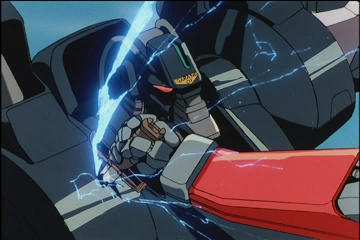 With a completely new cast of characters, ADV went for a different cast of voice actors. Jay Hickman ( Generator Grawl[/i], Excel Saga[/i]) takes the lead role as Eiji and does a fairly decent job, though he has the tough task of following up Vic Mognagna’s excellent performance as Shogo. Spike Spencer, who many fans will lovingly (hurhur) recognize as Shinji from Evangelion[/i], plays Eiji’s gamer-turned-psycho friend, Bud. The voice cast obviously had a good time in making this OVA sound intentionally cheesy, but you will enjoy the OVA a lot more this way. If you need an example of why the dub is better, there is a scene near the beginning where Ryo and Eiji talk about the Hard On video game. The dialog goes like this: RYO: “We’ll see tomorrow when the new Hard On goes up.” EIJI: “Oh man! I love playing Hard On. I beat it all the time.” 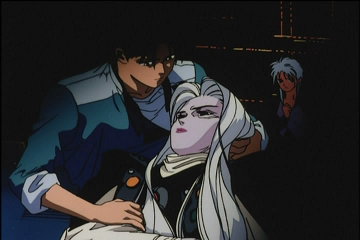 Ultimately, while Megazone 23 Part III[/i] is amusing, it is also pretty unnecessary. Though somewhat disappointing, Part II[/i] capped the story off fairly well, and Part III[/i] just feels like padding. There is one particularly great moment at the very end, but one can only ask oneself whether it was really worth it or not. If you enjoyed the first two OVAs, Part III[/i] is worth a look, as it provides a nice balance between Part I[/i] and Part II[/i]. Just try not to take it too seriously. - Shalashashka
Story: C
Animation: C
Design: B
Music: C
Direction: B
Overall: C
Sub or Dub: DubInterested in this anime? Buy it here!
|
|
|
|
Post by dai jou bu on Feb 29, 2008 13:00:11 GMT -5
... what? Okay, seriously, this is why dropping LSD before watching an anime is never a good idea. Or maybe it is. I dunno. assumptions like these only make you look like a donkey whist I masquerade a mule. I don't know about you, but I don't like the fact that people think I'm a mule. I only take sugar since that's a legal drug and is found in pretty much every sweetend food in America. Unless someone spiked the sugar cubes. |
|
|
|
Post by Ace Whatever on Mar 1, 2008 0:57:00 GMT -5
It sucks that Sunao Yoshida died during the production, but I think that's even more of a reason to complete the story. I'm sure Bandai will still be whoring out Gundam long after Tomino kicks the bucket. That comparison doesn't make sense, RO. How is making a direct continuation to an inconclusive plot whoring out? |
|
|
|
Post by Revolver Ocelot on Mar 8, 2008 18:37:25 GMT -5
Elfen Lied
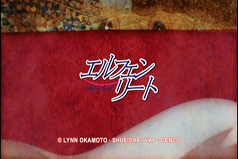
Studio: Genco, VAP
Director: Mamoru Kanbe
Writer: Takao Yoshioka
Producer: Kazuaki Morijiri, Manabu Tamura & Osamu Koshinaka
Composer: Kayo Konishi, Moka & Yukio Kondoo
Designer: Seiji Kishimoto
Released: July 25th, 2004
Genre: Horror, Unintentional Comedy
Format: Continuing TV series
Runtime: 13 episodes, 25 minutes each (325 minutes)
US License: ADV
 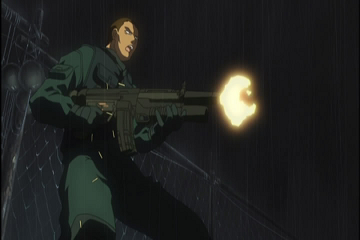
Elfen Lied, or as I like to call it, “ Evil Chobits”, is the story of a very “special” group of sinfully young ladies called “Diclonius”. The Diclonii are mutations born through what is believed to be an epidemic of genetic evolution. The girls are born with horns (which inexplicably resemble cat ears) and a varying number of invisible hands called “Vectors” that vibrate so intensely that they can slice through anything. They are considered especially dangerous, as they seek to destroy mankind and replace them with the Diclonii. 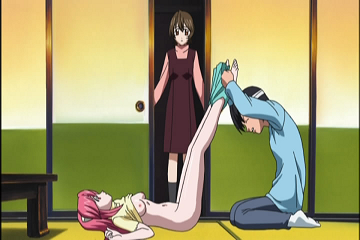  The Dicloinii are held in a specialized facility where a corporation is allowed to experiment on and with them. Japan’s just weird like that, I guess. Anyway, one of the Diclonii, Lucy, escapes from the facility and eventually finds herself living with a young man named Kohta, who by a series of extremely convenient plot devices, does not remember that he used to be best friends with her. But things are even more complicated than that, as Kohta has just decided to move in with his creepy cousin Yuka, who is just starving for his cock. Lucy’s alternate personality, the adorable, sweet, innocent “Nyu”, immediately takes a liking to Kohta, and this creates your obligatory anime love triangle. 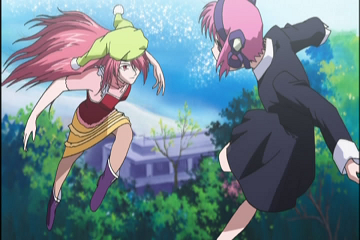 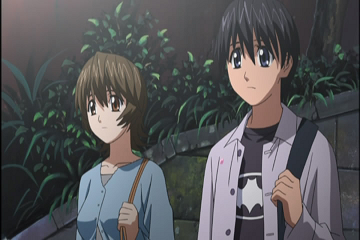 But Elfen Lied[/i] is no romance story. Not by a long shot. The aim of the show is to shock and appall. As Nyu periodically transforms back into Lucy, she goes on rampages, wantonly killing people in often hilariously gruesome ways. But the corporation that let her escape is not content to merely let Lucy do what she pleases. The nonsensical corporation decides that the best way to get rid of Lucy is to set EVEN MORE DANGEROUS Diclonii free into society to kill her. 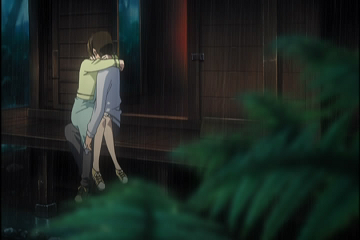  I am going to ahead and get this out of the way right now; Elfen Lied[/i] is pretty horrible. The plot is ridiculous, the characters are one-dimensional archetypes from harem and slice-of-life shows that just happen to kill things, and every step of the way, the show tries to shock the audience with elements like child molestation and incest. Poignant issues to be sure, but these issues have no purpose in this show. They are just there to captivate a certain demographic of ADD-afflicted anime fan. 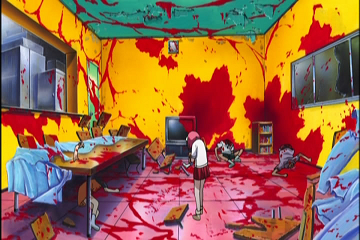  Elfen Lied Elfen Lied[/i]’s major problem is an almost total lack of explanation for anything. Why are the Diclonii trying to destroy humanity when they are capable of converting it by spreading the disease? Why is a non-military company allowed to experiment on these dangerous girls and then release them into the public? Why do they set other Diclonii loose to kill Lucy when it is clearly stated in the first episode that they can be killed by a sniper’s bullet to the head? Why does Kohta suddenly forgive Lucy for killing his sister and his dad? Is it because he got to finger her, perhaps? What purpose does Mayu have aside from satisfying loli fantasies? Oh, well, I guess I just answered that one myself. So much of this show just seems so pointless and juvenile. 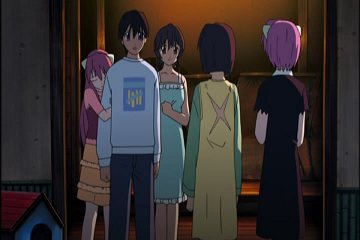 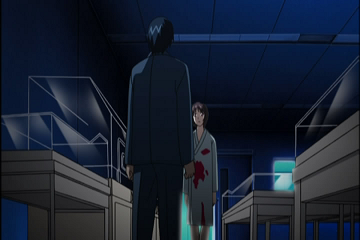 But Elfen Lied[/i] is not a total loss. Quite the contrary. Often times, its badness makes it entertaining. Aside from the gory, dismembering murder scenes, which are no doubt the highlights of the show, the nonsensical plot and ridiculous character motivations just make the show a delight sometimes. Not only does Elfen Lied[/i] take itself dead seriously, it actually thinks pretty highly of itself as it does so. For instance, this show thinks it is important enough to bring up the issue of child molestation. Child molestation is no laughing matter, but watching the 14 year old (who inexplicably looks like a 6 year old) Mayu get naked and then bend over in front of her father while he grins like Dick Dastardly from The Wacky Races is just too cheesy and hilarious not to laugh at. In another scene, Kohta accidentally comes to rub Nyu’s vagina. In response, she begins humping his hand while moaning “Nyuuuu!!” Seriously, people, what the fuck? The only thing this show is missing is a cardboard cutout of the silhouettes of Mike Nelson, Crow, and Servo to tape to the bottom of your TV screen so you can imagine them heckling it along with you. Those guys should really consider doing Rifftrax for anime. 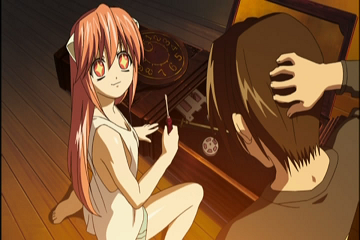 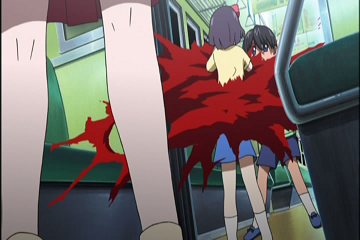 Elfen Lied Elfen Lied[/i], for a mere 1-cour show (a cour is the equivalent of a Japanese season; 12 ±1 episodes), does not look too hot. The art style is very clean, but it also looks pretty cheap. The character design is pretty bad. Everyone looks way too young. Kohta, Yuka and Lucy are supposedly 18, but they both look like they are 12 or 13. The animation is so-so. During the murder scenes, it is pretty smooth, but otherwise, nothing too impressive. The presentation is not entirely mediocre, however. The music selection is actually quite nice, particularly the opening theme.  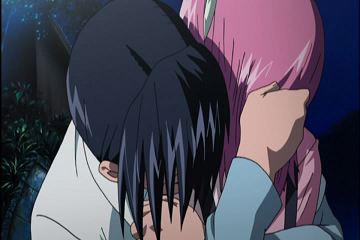 Elfen Lied Elfen Lied[/i] is going to go down as one of those shows most people call a masterpiece for reasons I will never understand, and frankly, I do not want to understand. It is a nonsensical mess with a completely incomprehensible ending. Elfen Lied[/i] is probably popular because it caters to every kind of perversion quite a few anime fans tend to have, from loli to pissing. But, for all its flaws and tastelessness, it is an entertaining, gory romp through the often silly world of anime. - Shalashashka
Story: C
Animation: C
Design: D
Music: A
Direction: D
Overall: C-
Sub or Dub: Sub
|
|
|
|
Post by Revolver Ocelot on Mar 8, 2008 23:16:30 GMT -5
Mobile Suit Gundam
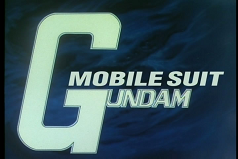
Studio: Sunrise
Director: Yoshiyuki Tomino
Writer: Yoshiyuki Tomino, Hiroyuki Hoshiyama, Yoshihisa Araki & Yu Yamamoto
Producer: Hoboyuki Okuma, Wataru Sekioka & Yasuo Shibue
Composer: Takeo Watanabe & Yuji Matsuyama
Designer: Yoshikazu Yasuhiko (characters) & Kunio Okawara (mecha)
Released: April 7th, 1979
Genre: Action, Drama, Mecha
Format: Continuing TV series
Runtime: 42 episodes, 25 minutes each (1050 minutes)
US License: BandaiAt the end of every episode of Mobile Suit Gundam[/i], the narrator rhetorically asks, “Who will survive?” This question is quite appropriate, as there was no guarantee you would see the same old faces again after the next battle. This was part of Gundam[/i]’s genius. It is hard, in this day and age, to appreciate what Yoshiyuki Tomino brought to the table with Gundam[/i]. Over the years, Gundam[/i] has become a mega-franchise with so many spin-offs, alternate universes, retellings, and merchandising that many anime fans, especially Americans who were not exposed to Gundam[/i] before the wonders of Cartoon Network, have become jaded with it. We have moved on to the greener pastures of shows like Cowboy Bebop[/i] and Fullmetal Alchemist[/i]. But would those shows be the same, or would they even exist, had it not been for Gundam[/i]? 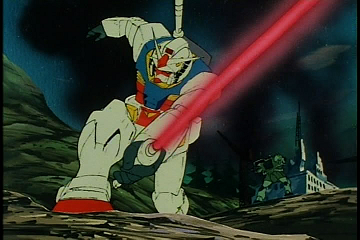 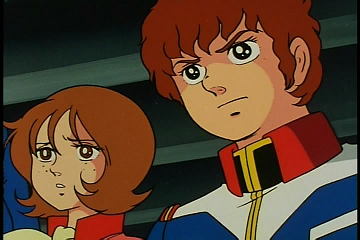 In the 70s, anime was primarily on the same level as cartoons in the US. They were meant for children. While there were many attempts to change this ( Space Battleship Yamato[/i] came close), the majority of anime in the 70s were simple, formulaic super-robot mecha shows that focused on the triumph of the human spirit over the forces of absolute evil. Yoshiyuki Tomino, who himself had directed several legendary super robot shows such as Brave Raideen[/i] and Daitarn 3[/i], sought to do something different with Mobile Suit Gundam[/i]. Rather than depict another good vs. evil battle, Tomino wanted to realistically depict war and the atrocities therein. Little did he know that, much like what Star Wars did for film, Gundam[/i] would completely change anime forever. 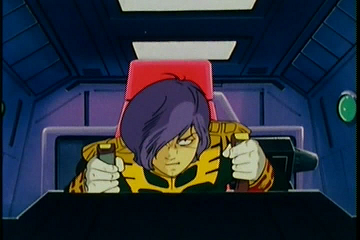 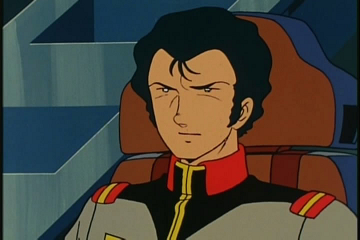 Gundam Gundam[/i] takes place in the distant future. Mankind has begun migrating to outer space, taking up residence in massive space colonies located in Lagrange points (pockets in Earth’s orbit where the pull of the Earth and Moon interact to create a stable gravity environment) around the Earth. 16-year-old Amuro Ray calls one of these colonies, Side-7, home. He has lived there with his father, who is an engineer for the military, since he was a small boy. But Amuro’s peaceful life is about to be interrupted. War has broken out between Earth and a group of colonies that have claimed independence. The self-proclaimed Principality of Zeon seeks to take over the Earth sphere, and has gone to such radical measures as dropping a colony on Earth, killing nearly half the people on the planet and permanently altering its environment. 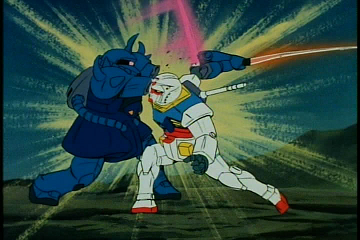 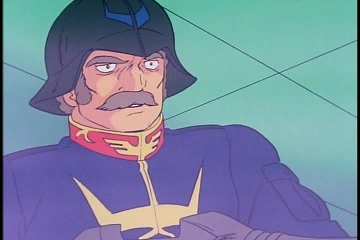 In response, the Earth Federation has begun a fierce war with the Zeon Empire, but they have been unable to gain a foothold in the conflict due to Zeon’s technological capabilities. The Zeons employ the use of mobile suits; giant, humanoid robots. More versatile and maneuverable than tanks and able to perform delicate tasks, the Zeon mobile suits have decimated the Earth Federation forces time and time again. But the Earth Federation has a plan. In the neutral region of Side-7, they are secretly building their own mobile suit, one so powerful and advanced that it could have the capability to end the war. However, information about this experimental mobile suit is leaked to the Zeons, and it is not long before Side-7, and Amuro Ray in turn, are caught up in the war. 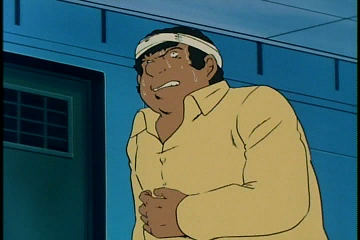 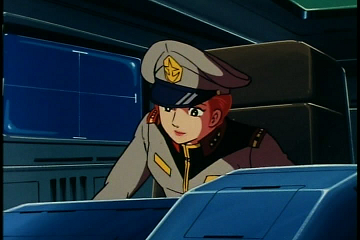 Gundam Gundam[/i] is dynamic in many ways. Foremost is the story. Gundam[/i] is not about giant robots at all. If you think that, you seriously have no idea. Gundam[/i] is about young people and how they are irreversibly changed by war. Amuro Ray is taken from his peaceful home along with several of his friends and other young people and is slowly molded into a soldier. Along with the usual details of a coming-of-age story, Amuro has to deal with many tough issues like the responsibility of other peoples’ lives, the deaths of his friends, and the incredible pressure of constantly fighting enemies he knows nothing about. Because of this, Amuro and the other characters who survive change quite dramatically over the course of the show, going through several phases of development. While this may sound fundamental in this day and age, in 1979, it was completely unprecedented. 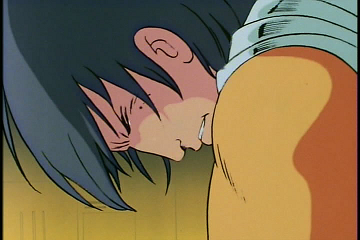 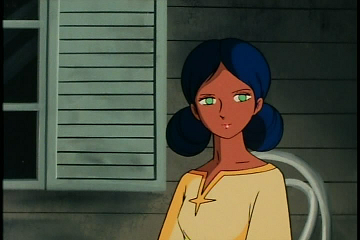 No anime before, and few anime shows since have even approached the level of breadth and depth of Gundam[/i]. The show is populated by an entire universe of characters that have more backstory than you even want to imagine. Almost every moment of these characters’ lives, and the history of the Universal Century in general, is written out somewhere in the many tomes and encyclopedias released in the show’s aftermath, and with painstaking detail at that. The feeling that Tomino had everything in this universe more or less laid out beforehand is very evident in the show itself, as it most definitely feels like you are in a real, living, breathing world with eons of history behind it. The best part is the way Tomino handles these characters. There are heroes and villains on both sides of the war, and we are never meant to explicitly sympathize with one side over the other. While characters like Amuro and Bright Noa are what are traditionally known as heroes, Zeons like Ramba Ral and the legendary Char Aznable (who is as recognizable in Japan as Darth Vader is in America) are just as likable and sympathetic.  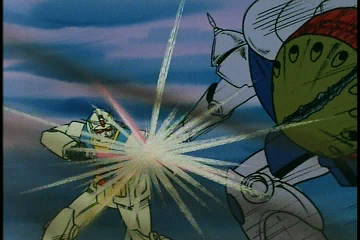 But, like even the greatest works of fiction, Gundam[/i] has its flaws. While the action and fight scenes are often spectacular in comparison to older mecha shows where robots would just throw their signature attacks back and forth, Gundam[/i] often relies on the battles as filler, and it occasionally gets mindless and dull. Another problem is Tomino’s over reliance on silly elements like Minovsky Particles and Newtypes to fill gaping plot holes. They are to Tomino what the Force and Midi-chlorians were to George Lucas. Whenever something nonsensical or inexplicable happens, it is always the same lame excuses. Why do the laser blasts keep conveniently missing the White Base? Because the density Minovsky Particles are keeping the enemies from getting a good lock on them, of course! Why is rookie Amuro able to take down Zeon’s most experienced, elite pilots like they were scrubs? Silly boy, Amuro is a Newtype! 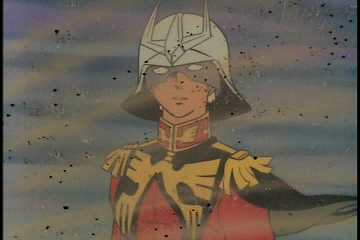 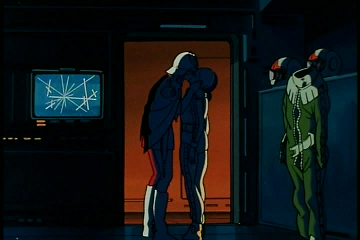 While Gundam[/i] certainly looks aged today, it was beautiful in 1979, and has stood up fairly well over the years. As to be expected of a show from the late 70s, the animation quality fluctuates regularly. This is particularly evident in the last few episodes, as budget cuts and last minute changes to the story structure were made to save the show from impending cancellation. The mecha design is very good. This is apparent in how iconic the Gundam and Zaku are. Even folks not familiar with the Gundam[/i] franchise itself recognize these machines even more than the characters who pilot them. On top of the visual side of the presentation, Gundam[/i] also has some exceptional orchestral music mixed in with some disco, more evidence of the show's vintage. 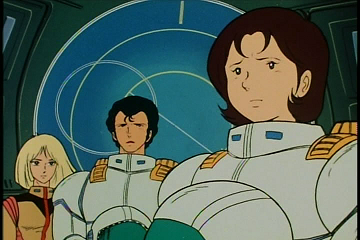 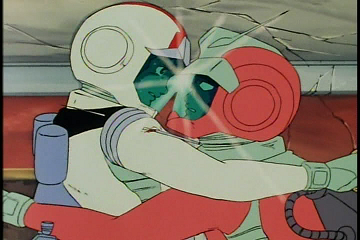 Gundam Gundam[/i] was a monumental series. It provided its small, niche audience with unprecedented levels of depth and drama. Although the show was cut short of its intended run due to low ratings, thanks to the compilation movie trilogy, Gundam[/i] gained massive notoriety, and in its wake, anime was changed forever. Without the advents Gundam[/i] brought along, anime may have never gone through the maturation it has not only embraced, but has become encapsulated by. I recommend Gundam[/i] to everyone, as it is a crucial part of anime history, and it touches on themes that touch all human beings fundamentally. Pick up Bandai's 10-DVD release of the series. Although it only offers English audio, the show has a very strong dub, and the video is beautifully remastered. If you are really not big on this sort of thing, then you might want to skip the series and watch the movie trilogy, as it tells the same incredible story without the filler. - ShalashashkaNote: The show is actually 43 episodes long, but episode 15 was cut due to Tomino feeling it was extremely poor quality. Somehow, episode 16, which is way worse, managed to stay. Ah well. The original episode 15 has never been released on DVD. Story: B
Animation: A
Design: A
Music: A
Direction: S
Overall: A-
Sub or Dub: Dub, for the great voice acting and remastered video.
|
|
|
|
Post by Vendaval Este on Mar 9, 2008 3:54:24 GMT -5
Elfen Lied is just angsty emo pap, she even gets her fringe covering one eye. Also, GUNDAM FUCK YEAH!
|
|
|
|
Post by necromaniac on Mar 9, 2008 7:21:43 GMT -5
Elfen Lied manga is much better than the show as it goes it way to actually explain things.
Every complaint you made in your review ocelot is the fault of the retarded changes they made to it! The manga explains things, has more realistic and less frequent "chobits" moments, and is even curler to it's characters (there's no forgiveness in it, for example)
What the show did right though where the first ten minuets (one of the most memorable starters in recent anime history), It's beautiful opening and Lilium, the theme we keep hearing trough the series.
|
|
|
|
Post by Revolver Ocelot on Mar 14, 2008 18:35:31 GMT -5
Trigun
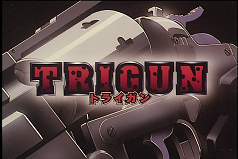
Studio: Madhouse
Director: Satoshi Nishimura
Writer: Yousuke Kuroda & Yasuhiro Nightow (manga)
Producer: Masao Morosawa & Shigeru Kitayama
Composer: Tsuneo Imahori
Designer: Takahiro Yoshimatsu (characters) & Noriyuki Jinguji (mecha)
Released: April 1st, 1998
Genre: Action, Comedy, Drama, Gunslinging
Format: Arcing TV Series
Runtime: 26 episodes, 25 minutes each (650 minutes)
US License: Geneon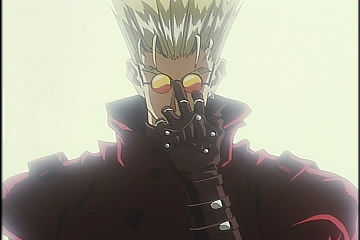 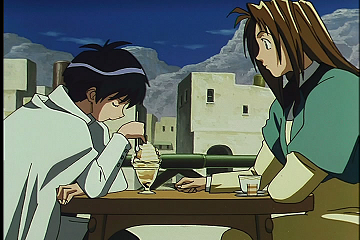 Vash the Stampede is a problem. Everywhere he goes, he leaves ruins behind him. Because of this, he has garnered the title “The Humanoid Typhoon” and there is a bounty on his head for $$60,000,000,000. But is Vash really as bad as everyone says he is? By all accounts, he appears to be a completely inept moron who refuses to engage in any sort of violence. A pair of insurance agents, Meryl and Milly, are about to find out as they tag along with him and document the destruction he leaves in his wake. As they do, they meet a myriad of colorful characters and treacherous villains, and slowly uncover the truths behind Vash's mysterious past. 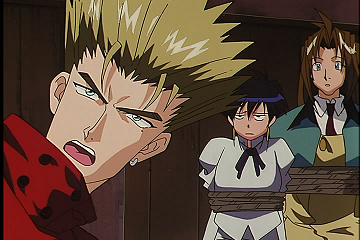 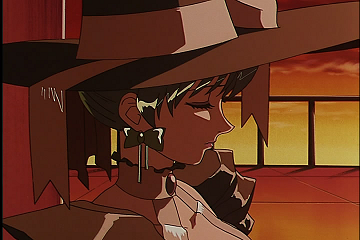 As one of the greatest anime phenomenons to hit America thanks to its early DVD release by Geneon (then Pioneer) and its later run on Cartoon Network's Adult Swim, there is not much I can tell you about Trigun[/i] that you do not already know. Few shows before or since have garnered as much critical acclaim or publicity stateside. It is ranked along with the likes of Cowboy Bebop[/i] and Fullmetal Alchemist[/i] as one of the greatest anime shows ever. But is it worth the hype? 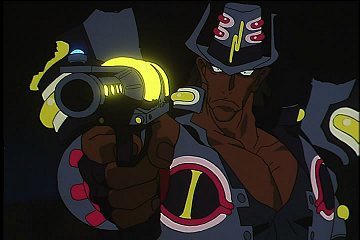 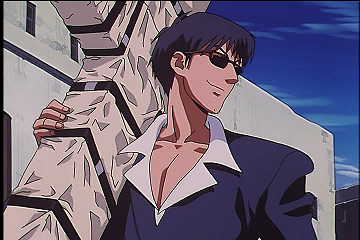 Let me begin answering this question by discussing Trigun[/i]'s biggest problem; its pacing. Trigun is off to a very, very slow start. The first half of the show consists of completely inconsequential, episodic ventures. They are somewhat amusing, but have no baring on the story whatsoever. It is not until the Gung-Ho Guns show up slightly after the halfway point that any real development begins to take place with the story or its characters. Once the story begins to pick up, however, we are presented with another problem; so much time has been wasted with the first half that as interesting as the second half is, it feels compressed and rushed, like the writers were trying to explain way too much in too short a span of time. Due to this, we barely get anything more than a passing glance at characters like Legato or the relationship between Vash and his brother Knives. Hell, by the end of the show we do not even really know who or what Vash and Knives are. 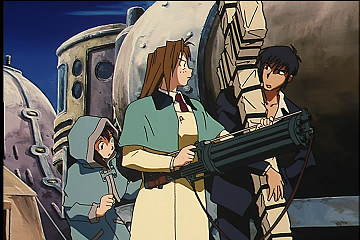 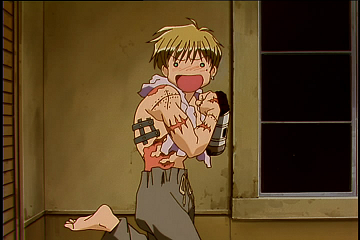 Another problem Trigun[/i] has is its mood. It cannot quite decide whether it wants to be a comedy or a drama, and often times, the jump from silly to serious is often too abrupt and jarring to work effectively. On top of that, the situations that are supposed to be serious are usually too cliché for one to feel invested in anyway. In almost every instance, Trigun[/i] works much better when it is not taking itself seriously. 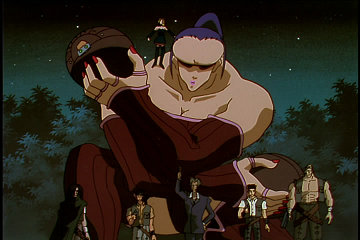 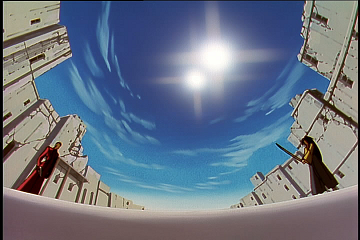 One thing Trigun[/i] never fails at, however, is being entertaining. Throughout the show, Vash and his friends (particularly, the awesome Nicholas D. Wolfwood) meet a variety of adversaries they will have to deal with, and almost every one of these confrontations is represented by some of the finest action sequences to be seen during its day. While nothing here blew my mind quite like some of the more intense scenes in the earlier released Outlaw Star[/i], Trigun[/i] still does a fine job of being fun. 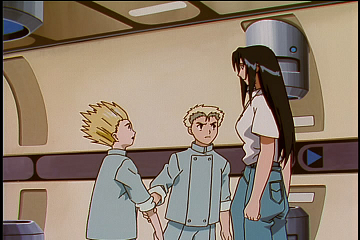 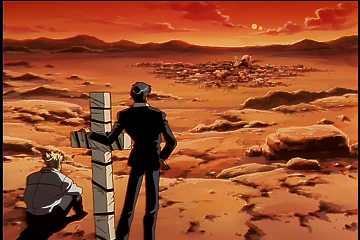 Trigun Trigun[/i]'s most overrated aspect is probably its animation. It really is not at all amazing. Not bad, of course. I would go as far as to say it is above average. But there were plenty of shows released around the same time ( Outlaw Star[/i], Cowboy Bebop[/i]) and even shows released long before ( Escaflowne[/i], Evangelion[/i]) that completely blow Trigun[/i] out of the water in terms of both animation and artwork. The biggest problem is the glaring inconsistency. Not just between episodes, but even in between certain parts within episodes, there are areas where Trigun looks great and areas that look utterly mediocre. 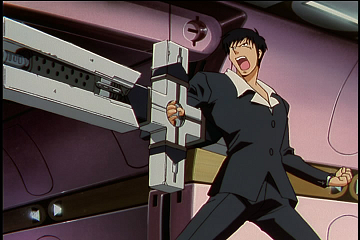  One area where I can not argue with the masses regarding Trigun[/i] is its music. Tsuneo Imahori has done a wonderful job creating a soundtrack that perfectly captures the aura of the show's visual atmosphere. The great bass and percussion work do for Trigun[/i] what Yoko Kanno's incredible jazz pieces did for Cowboy Bebop[/i], adding a whole new dimension to the character of Trigun[/i] as a show. Assisting the music is a fairly good dub job by actors such as Johnny Yong Bosch (who became a sort of voice acting demi-god after Trigun[/i]), Jeff Nimoy and others providing some very convincing voiceovers for the characters.  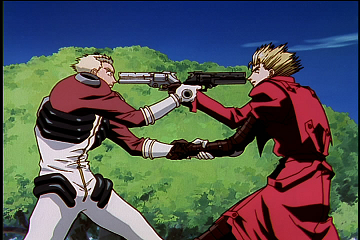 My overall feelings about Trigun[/i] are that it is overrated. But I really cannot hate on it. It is a good show. But it could have been a whole lot better with some more focus and more fleshing out of its characters. It has, more than anything, a great sense of character thanks to its atmosphere and design, and it is also highly entertaining. I recommend it to just about anybody, especially if you like action. - Shalashashka
Story: C
Animation: B
Design: S
Music: A
Direction: A
Overall: B+
Sub or Dub: Either
|
|
|
|
Post by Isao Kronos (BANNED) on Mar 15, 2008 0:52:08 GMT -5
If you want to do anything Trigun related, go read the manga (Trigun and Trigun MAXIMUM). I hear they're better.
|
|
|
|
Post by Revolver Ocelot on Mar 15, 2008 2:11:14 GMT -5
That's what most people tell me, but I just can't read manga for some reason.
|
|
|
|
Post by Revolver Ocelot on Mar 16, 2008 3:18:42 GMT -5
Ghost in the Shell
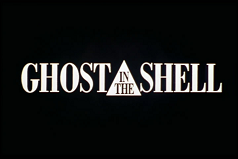
Studio: Production I.G.
Director: Mamoru Oshii
Writer: Kazunori Ito & Masamune Shirow (manga)
Producer: Ken Iyadomi, Matsuhisa Ishikawa & Shigeru Watanabe
Composer: Kenji Kawai
Designer: Hiroyuki Okiura (characters), Atsushi Takeuchi & Shoji Kawamori (mecha)
Released: November 18th, 1995
Genre: Action, Cyberpunk, Thriller
Format: Theatrical Movie
Runtime: 83 minutes
US License: Manga
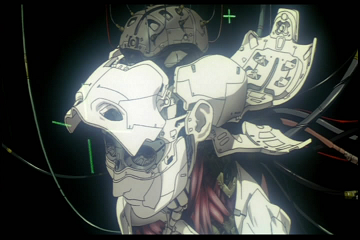
Ghost in the Shell needs no introduction. Few works of animation have ever received the amount of hyperbole and critical lauding that it has, and even now, over 12 years after its release, many still call it one of the greatest works of animation ever made. Even those not familiar with anime have at least heard of Ghost in the Shell[/i], and many of them have seen it and claim that it is the finest anime out there. That, however, is a bit of a problem. 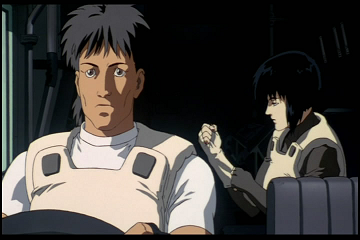 Ghost in the Shell Ghost in the Shell[/i] falls into a classification of anime I like to call “Ignorant White Folk Masterpieces”. The title of the classification alludes to the fact that quite a few people who really know nothing about anime (James Cameron, Roger Ebert) like to say some animes (usually movies) are masterpieces of animation despite the fact that they really do not have the necessary experience with the industry to make such claims. Movies like Ninja Scroll[/i], Akira[/i], and many Miyazaki flicks fall into this category, but Ghost in the Shell[/i] could quite possibly be the poster child of this classification. 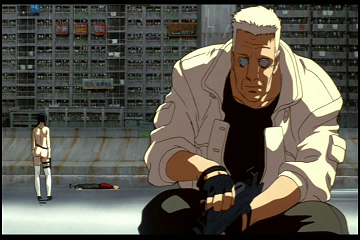 Ghost in the Shell Ghost in the Shell[/i] is a cyberpunk thriller much akin to the likes of Blade Runner and Liquid Sky. The difference is that while those movies were actually about something, Ghost in the Shell[/i] is not. It does not start out that way, though. It gives off a great first impression, sucking you right into the setting. It is the future. The net controls everything, and netjackers and hackers pose a major threat, particularly the mysterious entity known as The Puppet Master. Section 6, a special team of part-cyborg enforcers, are tasked with bringing down the netjackers associated with The Puppet Master. Amongst them are the burly badass Batou, sly gunslinger Togusa, and the star of the show, the sultry colonel Kusanagi. 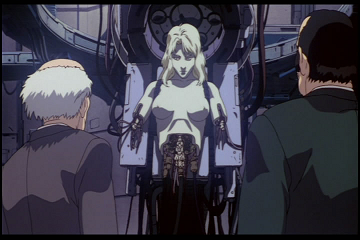 Ghost in the Shell Ghost in the Shell[/i] is certainly off to a great start, but this soon fades. After the mindless but fun action sequences are over, the film's plot begins to degrade into a garbled mess of pointless nonsense and self-importance. Coupled with a lot of incomprehensible techno-jargon, this is perceived as depth by many people. But really, the Descartesian existentialist concepts brought up by the film have no more depth than what you would get in a community college calibre philosophy course. Life is a mystery, our purpose in the universe is uncertain. We get it. Please, let us move on. 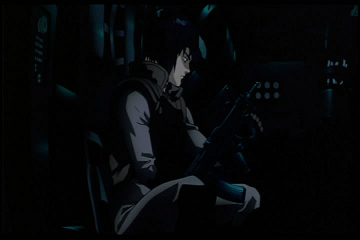 While Ghost in the Shell[/i] is wasting time trying so hard to be profound when it should be using it to be entertaining, it spends its entire 83 minutes of runtime looking quite gorgeous. Though television anime was really starting to get pretty towards the mid-90s, Ghost in the Shell[/i] showed that there was still quite a large rift between what was capable with a 25-50 episode show and a feature film little over an hour long. Though the gap has been steadily closing, Ghost in the Shell[/i] still looks better than most TV shows today. At the same time, however, it does not stand out much from some of the other movies of its day such as Porco Rosso[/i] and the much older Akira[/i], so anyone who tells you it is the best looking thing ever is putting on a bit of a show. 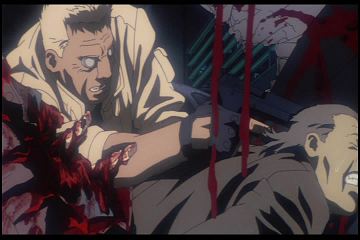 Aside from the magical Celtic opening song, none of the music in Ghost in the Shell[/i] really stands out. This is largely by design. The objective here was atmosphere over style, and the silence helps build the tension. The sound of the action provides most of the musical backdrop. The usually muted ambiance of anime is discarded here in favor of a very realistic, layered complex of every sound you can imagine, making Ghost in the Shell[/i] seem that much more like a live-action Hollywood blockbuster than an animated feature. 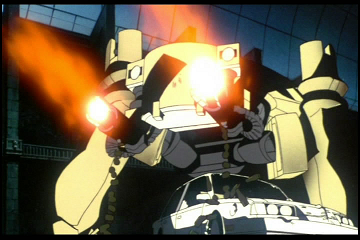 In the mid 90s, it was becoming quite common for US distribution studios to use mid-profile Hollywood actors to do voicework in anime feature films. While this usually adds an element of publicity, it can sometimes be a bit awkward. Ghost in the Shell[/i] tactfully avoided this approach and used experienced, veteran voice actors. As a result, we get a very rich, natural feeling to many of the characters, though some of them sound as if they were intentionally dulled to remind us that most of them are cyborgs. 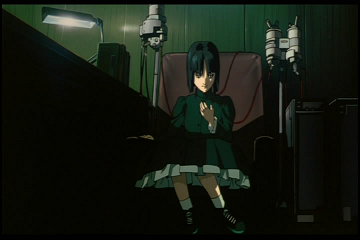 Ghost in the Shell Ghost in the Shell[/i] remains a legend in the anime world, and is often regarded as one of the greatest works of animation ever to grace the big screen. The picture appeals to both ends of the viewing spectrum. The thrill seekers are immediately drawn in by the naked chick and the exploding head that appear about a minute into the movie, and the Criterion Collection geeks who claim genius are sold by the philosophical notions and the pretentious ending. But for me... well, sorry, guys. It takes a little bit more than tits, gore and elementary philosophy to impress me. Every time I hear someone say this is one of the best animes ever I just roll my eyes and say “Yeah... you should really watch some anime.” - Shalashashka
Story: D
Animation: S
Design: B
Music: B
Direction: D
Overall: C
Sub or Dub: Either
|
|
|
|
Post by hashin on Mar 16, 2008 4:45:53 GMT -5
This movie was one of the first things I dled in my life and it was dubbed. The animation is amazing, but I couldn't understand anything that was happening. I never had interest in watch a subbed version, I thought it wouldn't make difference. Guess I was right.
|
|
|
|
Post by YourAverageJoe on Mar 16, 2008 5:38:38 GMT -5
I liked that movie. It wasn't HOLY SHIT AWESOME, but at the very least I thought most of the action scenes were very well done and the characters are pretty likable.
|
|
|
|
Post by Ace Whatever on Mar 16, 2008 8:17:29 GMT -5
It's the one and only anime so far that I fell asleep watching.
|
|